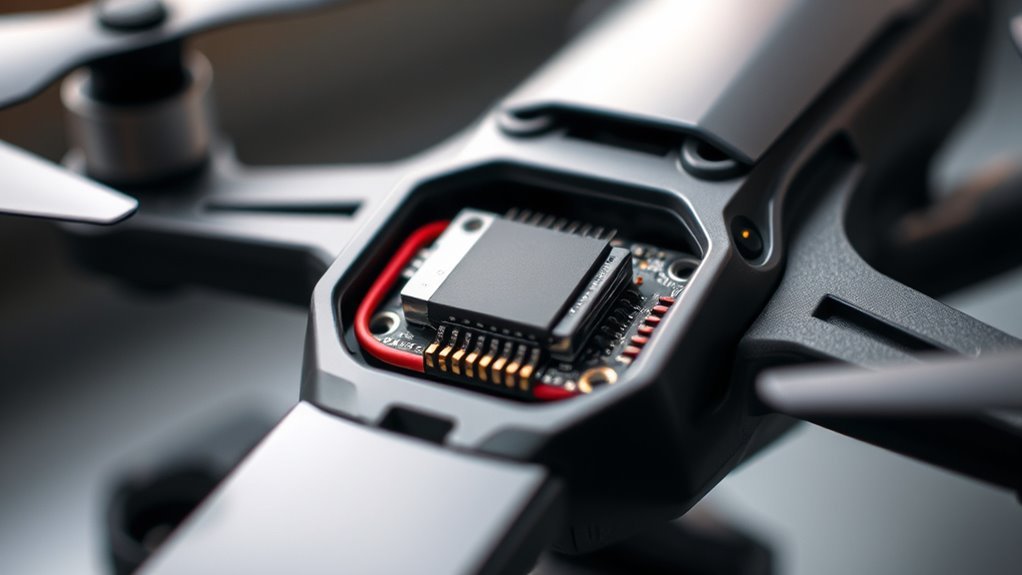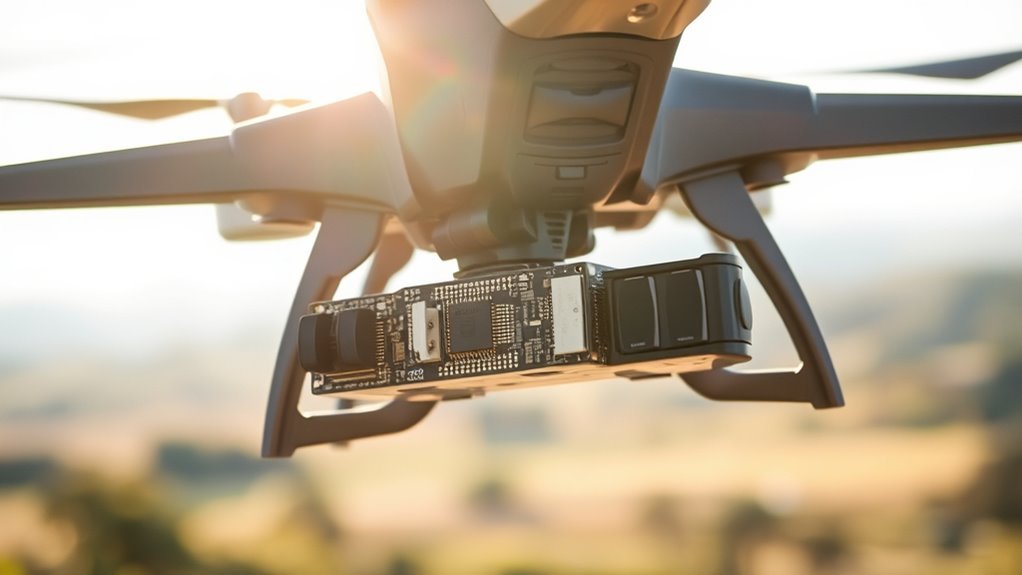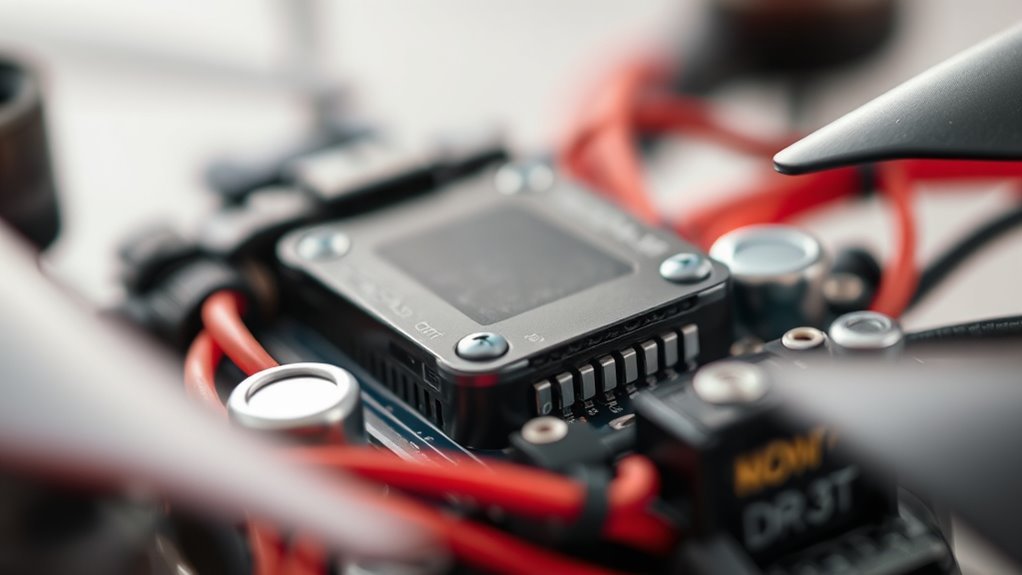An Electronic Speed Controller (ESC) is essential for optimizing your drone’s performance, as it regulates motor speed and direction based on flight controller signals. ESCs convert control inputs into precise motor control, improving responsiveness and stability during flight. When choosing an ESC, consider the type, specifications like current and voltage ratings, and guarantee proper installation techniques to minimize resistance and enhance performance. Understanding these aspects will equip you with the knowledge to maximize your drone’s capabilities.
What Is an Electronic Speed Controller (ESC)?

An Electronic Speed Controller (ESC) is an essential component in drone systems, acting as the intermediary between the flight controller and the motors. Its primary ESC functions include regulating motor speed, direction, and braking. By interpreting signals from the flight controller, the ESC adjusts the power delivered to each motor, enabling precise control for flight maneuvers. When selecting an ESC, you’ll want to take into account ESC specifications such as current rating, voltage compatibility, and response time, all of which impact performance and reliability. A well-chosen ESC can enhance your drone’s responsiveness and overall flight experience, allowing you the freedom to explore the skies with confidence. Understanding these elements is fundamental for optimizing your drone’s capabilities.
How ESCs Work in Drone Flight

While flying a drone, understanding how Electronic Speed Controllers (ESCs) operate is essential for achieving ideal performance. ESCs serve as the vital link between your drone’s flight controller and its motors, converting control signals into precise motor control. When you adjust the throttle, the ESC interprets these signals, regulating motor speed and ensuring best throttle response. This immediate feedback loop allows for rapid adjustments, enhancing maneuverability and responsiveness during flight. By modifying the voltage sent to the motors, ESCs enable smooth acceleration and deceleration, giving you greater control over your drone’s movements. A well-functioning ESC can greatly improve flight stability, allowing you to explore and enjoy the freedom of the skies with confidence.
Types of ESCs: Choosing the Right One for Your Drone

Selecting the right Electronic Speed Controller (ESC) for your drone is essential, especially as different types offer distinct advantages based on your specific flying needs. For drones equipped with brushless motors, you’ll typically encounter three main types: traditional, high-speed, and programmable ESCs. Traditional ESCs provide basic functionality and are often the most cost-effective. High-speed ESCs support rapid throttle response, ideal for racing drones. Programmable ESCs allow you to customize settings, enhancing performance tailored to your flying style. When evaluating options, pay close attention to ESC ratings, which indicate the maximum current and voltage they can handle. Matching your ESC to the motor’s specifications guarantees peak efficiency and performance, allowing you the freedom to explore your drone’s full capabilities.
Installation and Setup of ESCs
Proper installation and setup of Electronic Speed Controllers (ESCs) is essential for guaranteeing ideal performance and reliability in your drone. To achieve this, follow these key steps:
- Use appropriate wiring techniques: Choose the right gauge wire to minimize resistance and guarantee efficient power delivery.
- Soldering tips: Use a high-quality soldering iron and rosin core solder for strong, reliable connections.
- Secure ESCs properly: Mount them away from heat sources and guarantee they’re well-ventilated to prevent overheating.
- Calibrate your ESCs: Follow the manufacturer’s instructions to set throttle ranges, guaranteeing your drone responds accurately to your controls.
Common Issues and Troubleshooting ESCs
When working with ESCs, overheating can often indicate underlying issues that need addressing. You might also encounter calibration problems that affect performance, as well as signal interference that disrupts communication. Understanding these common issues will help you troubleshoot effectively and maintain peak drone functionality.
Overheating Problems Explained
Although electronic speed controllers (ESCs) are vital for drone performance, they often face overheating issues that can severely impact functionality. Understanding the overheating causes and implementing effective overheating prevention strategies are essential for maintaining peak performance. Here are some common factors contributing to overheating:
- High current draw during demanding maneuvers
- Inadequate ventilation or airflow around the ESC
- Poorly calibrated settings, leading to excessive stress
- Subpar components or connections that increase resistance
To prevent overheating, guarantee proper airflow, regularly check connections, and use quality components. Monitoring your ESC’s temperature and being aware of your drone’s flight demands will help you maintain control over its performance, allowing you the freedom to push boundaries without compromising reliability.
Calibration Issues Identified
Overheating issues can often be exacerbated by improper calibration of electronic speed controllers (ESCs). When you’re working with drones, utilizing effective calibration techniques is vital. If your ESCs aren’t properly calibrated, you might experience erratic motor responses or reduced efficiency. Pay close attention to sensor alignment; misalignment can lead to inconsistent throttle output, increasing the risk of overheating. It’s important to follow the manufacturer’s guidelines for calibration procedures, guaranteeing that all settings are optimized for your specific drone. Regularly check and recalibrate your ESCs to maintain peak performance. Taking these steps not only enhances your drone’s reliability but also guarantees you have control over your flying experience, embracing the freedom that comes with well-tuned equipment.
Signal Interference Solutions
Even if your ESCs are well-calibrated, signal interference can lead to significant performance issues in drones. To tackle this, consider implementing the following solutions:
- Use signal shielding to prevent electromagnetic interference from affecting your ESCs.
- Employ frequency hopping techniques that allow your drone to switch between various frequencies, reducing the risk of jamming.
- Position your ESCs away from high-interference components, like motors and batteries, minimizing cross-talk.
- Regularly check connections to verify they’re tight and secure, reducing potential weak signals.
Maintenance Tips for Optimal ESC Performance
To guarantee ideal performance from your electronic speed controllers (ESCs), regular maintenance is essential, especially since these components directly affect your drone’s flight stability and efficiency. Start with ESC cleaning; make certain you remove dust and debris to prevent overheating and signal issues. Use compressed air for hard-to-reach areas, and avoid liquid cleaners that might damage sensitive components. Additionally, keep your firmware updated. Manufacturers often release updates that improve performance and fix bugs, so regularly check for new versions. You can usually do this through your ESC’s configuration software. By prioritizing these maintenance tasks, you’ll not only extend the lifespan of your ESCs but also enhance your drone’s overall performance, allowing you the freedom to fly worry-free.
Frequently Asked Questions
Can ESCS Be Repaired if Damaged?
Yes, ESCs can be repaired if damaged. Conduct a thorough damage assessment first, then apply appropriate repair techniques, like soldering or replacing components. However, make certain you’re skilled enough to avoid further complications during the process.
What Is the Lifespan of a Typical ESC?
A typical ESC’s expected lifespan ranges from one to three years. Factors affecting longevity include temperature, usage frequency, and power surges. Keeping these in mind can help you maximize your ESC’s performance and reliability.
How Do I Clean My ESC?
Imagine dust clinging stubbornly to your ESC. For effective ESC maintenance, use compressed air to gently blow away debris. Then, a soft brush can remove stubborn particles, ensuring peak performance and longevity for your device.
Can I Use a Different Brand ESC?
Yes, you can use a different brand ESC, but verify brand compatibility. Different brands may affect ESC performance, so check specifications to maintain peak efficiency and prevent potential issues with your drone’s overall functionality.
What Voltage Rating Do I Need for My ESC?
When choosing your ESC voltage, you’ll want to guarantee it aligns with your battery’s voltage. Proper ESC compatibility is essential; mismatched ratings can lead to inefficiency or damage, limiting your flying freedom.

